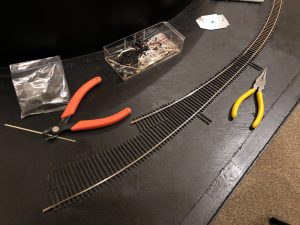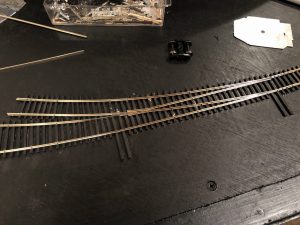
Yesterday was an eventful day in two ways. First, it was our first day under “stay at home” orders for COVID-19 in Colorado. Second, the extra time gave me a chance to hit a major milestone on the St. Charles Branch–the first sections of track!!!
The first piece was a section of flex track for the Southern Railway staging yard representing Appalachia, VA. I’m hand laying all the track on the visible section of the layout, but I’ll be using Atlas Code 83 flex track for the staging yards, helices and hidden track. The flex track is recycled from my former layout representing the Interstate Railroad’s Dixiana Branch, and I’ve got plenty!

I am hand laying the switches in the staging area, and I started the first two switches yesterday. I’m using the method Tony Koester outlined in Model Railroader a couple decades ago. As you can see, it’s an outside-in method and requires no fancy tools, just rail nippers, needle-nosed pliers, a flat file, a triangle file, a bench vise, soldering iron, and an NMRA track gauge. I’m using Micro Engineering Code 83 rail and small spikes here. The tool set is rounded out with a freight car truck to check things as you go.

It’s been more than 5 years since I hand laid a switch, but I’ve found it’s like riding a bike (I looked but couldn’t find where I’d put Tony’s article, so it was all from memory). One lesson I carried over from my previous layout is to pay special attention to two things on the frog: 1) make sure the track is at the tightest acceptable gauge at the frog, and 2) take extra time to make the rails line up perfectly with the point of the frog.



